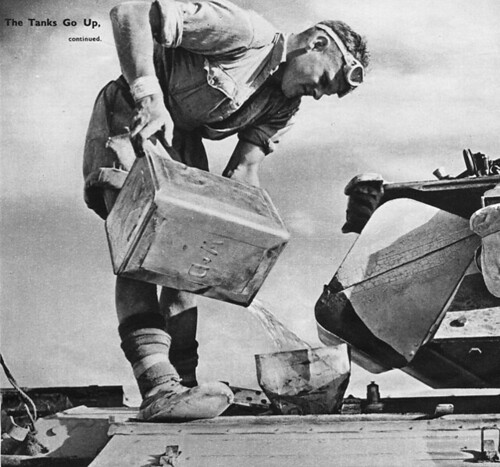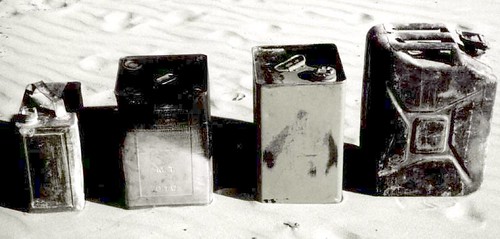
At the beginning of the North Africa Campaign in WWII, the British faced a logistics problem on a scale they’d never imagined. In this, the first totally mechanized war, the need for fuel staggered existing supply lines—and existing supply containers. For several decades the British military had made do with a squarish four-gallon soldered-tin can known officially as a POW can—for Petrol, Oil, and Water—to move the bulk of its petrol supplies. The four-gallon size was light enough to be handled by one man (unlike the common 55-gallon drum), and small enough to be transported by light truck or even motorcycle.
But as General Wavell in Cairo mustered his tanks, trucks, and airplanes to counter the forces of the Italians and Germans massing in Tripolitania and Cyrenaica (now Libya), the deficiencies of the POW can quickly became all too clear. Stacked in pallets on cargo ships, the weight of the top layers simply crushed those below, resulting in fuel losses of up to 40 percent, and making unloading the intact containers extremely hazardous with thousands of gallons of petrol sloshing around in the bilges and the fumes powerful enough to render seamen unconscious, not to mention the danger of fire or explosion.
 A British soldier refuels a Crusader tank from a flimsy. The funnel appears to have been made from another flimsy.
A British soldier refuels a Crusader tank from a flimsy. The funnel appears to have been made from another flimsy.
Even in smaller shipments the can proved absurdly fragile. Truck transport over 100 miles of desert track frequently left 20 to 30 percent of the contents cascading out the tailgate. In his book The Desert War, Alan Moorehead wrote, “The great bulk of the British Army was forced to stick to the old flimsy four gallon container, the majority were only used once. We could put a couple of petrol cans in the back of a truck, two hours of bumping over desert rocks usually produced a suspicious smell. Sure enough we would find both cans had leaked.”
That adjective, “flimsy,” quickly became a noun, and the POW can became universally known as the flimsy, reviled by troops and brass alike. To get an idea of the numbers used, consider that a single Wellington bomber flying a single nine-hour sortie needed 270 flimsies to fill its tanks. Piles of empty containers 30 feet high stood outside every airbase, and littered the Western Desert wherever British vehicles ranged.
Fortunately, an alternative presented itself when the retreating German Army began abandoning its own 20-liter containers. These were of embarrassingly brilliant design—perimeter-welded of stout steel for strength, with a three-handle configuration that allowed one man to carry two empty cans with one hand (or two full cans if he was strong), and which facilitated effortless hand-off of full cans down a line of men. The leak-proof cap was secured with a fast and foolproof lever, a breather allowed fast pouring, and a clever air trap at the top meant that a full can of petrol would float in water. The British scrounged all the “jerry cans” they could, and in England the design was unashamedly copied to the last detail—two million of them would be sent to North Africa before the end of the campaign. (The U.S. copied the design as well, but substituted cost-saving—and inferior—rolled seams and a screw top that was difficult to seal.)
 A British two-gallon container, early and later "improved" four-gallon flimsies, and the vastly superior German 20-liter fuel can. Note the thin and awkward handle of the flimsy.In the meantime, the flimsy proved happily more useful as a makeshift device than it did in its primary role. Filled with sand, it became an impromptu building block for gun emplacements and buildings. Cut in half and filled with petrol-soaked sand, it was used as a stove for boiling water (in another half-flimsy), and known as a Benghazi burner or Benghazi boiler (the latter term was subsequently applied to the Thermette, an early volcano kettle supplied to troops from New Zealand).
A British two-gallon container, early and later "improved" four-gallon flimsies, and the vastly superior German 20-liter fuel can. Note the thin and awkward handle of the flimsy.In the meantime, the flimsy proved happily more useful as a makeshift device than it did in its primary role. Filled with sand, it became an impromptu building block for gun emplacements and buildings. Cut in half and filled with petrol-soaked sand, it was used as a stove for boiling water (in another half-flimsy), and known as a Benghazi burner or Benghazi boiler (the latter term was subsequently applied to the Thermette, an early volcano kettle supplied to troops from New Zealand).
The Benghazi burner was also effective for illuminating rough landing strips at night—and that was quite possibly the role played by the crudely bisected Shell example we found in Egypt’s Western Desert this February (top photo). It speaks to the extreme aridity of this eastern edge of the Sahara that after 70 years even something as thin as a flimsy was still in recognizable shape.
